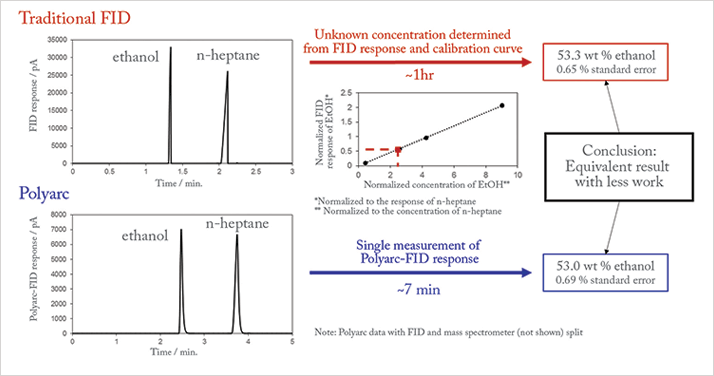Brad Cleveland and I (Andrew Jones) founded Activated Research Company (ARC) in July 2014. I had just finished my PhD in Chemical Engineering focusing on catalysis at the University of California, Berkeley. Brad brought 13 years of experience as CEO of Proto Labs. We wanted to create a company that improved lives using catalysis; we believe our first product really embodies this spirit. Kimberly Herzog, also a chemical engineer, soon joined us to lead commercialization of the product. We all share the same roots: the University of Minnesota, Twin Cities.
The Polyarc is a small catalytic reactor, born out of Paul Dauenhauer’s research lab at the University of Minnesota, that converts gaseous carbon-compounds into methane. When integrated after column separations in gas chromatography (GC) systems, flame ionization detection (FID) of the resulting methane leads to a higher and equivalent sensitivity on a per carbon basis (see Figure 1). We have finished beta testing trials with very positive results and feedback, and are finishing up a more extensive pilot testing of the product at a number of universities and global corporations.

The product improves GC-FID analysis in three main ways: Calibrations of FID response factors for individual components are no longer required because methane is the only gas created, eliminating the need for expensive standards and also saving time. CO, CO2, formic acid, formaldehyde – and many other compounds – that have little-to-no response in a typical FID are all converted into methane, allowing their detection with an equivalent per carbon sensitivity. Integration of peaks from unknown compounds gives the carbon content of those compounds, allowing users to close their carbon balance, estimate carbon fractions, or determine purity without knowledge of the exact structure or molecular weight.
The reactor is a two-step catalytic process. Carbon-containing molecules are first combusted on a metal catalytic surface into CO2 and the resulting CO2 is subsequently reduced to form CH4. We have spent the last year developing the technology to optimize the internal reactor design and catalytic support, mitigate any impact on separation performance, and ensure long-life and complete conversion of a wide variety of carbon compounds. We have done extensive testing and have yet to find a molecule that doesn’t work with the Polyarc, which can be seamlessly integrating into existing GC-FID systems.
ARC is dedicated to doing everything we can to ensure this product makes our customers’ lives easier and improves their GC-FID analytics. We are very excited for our full product release, which will happen once our pilot program is wrapped up. We have also scaled our operations to meet what we expect will be a very large demand. We can’t discuss any future products at this time, but we can tell you they will be equally compelling and, of course, involve catalysis.




